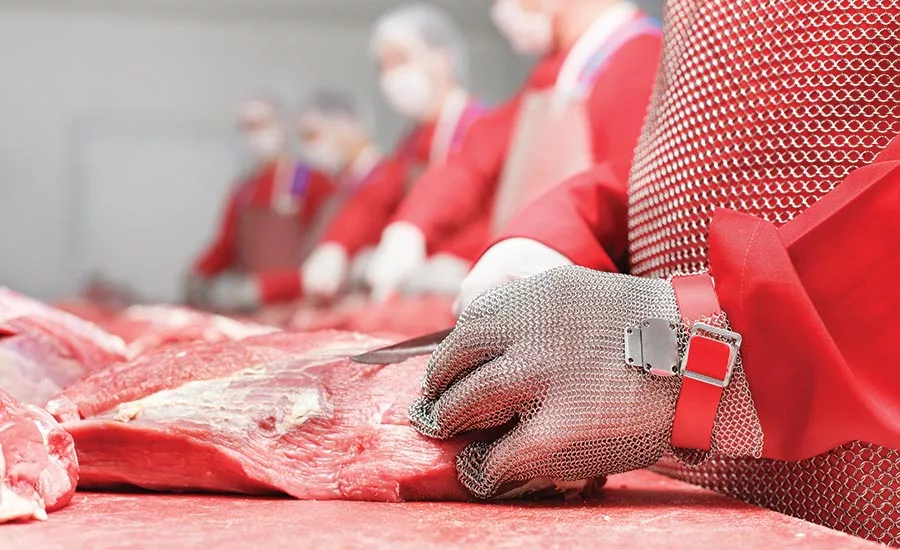5 things food manufacturing leaders need to know about non-desk employees

Workers in refrigerated environments dress in personal protective equipment that helps keep their bodies at a comfortable and safe temperature.
Photo courtesy of Getty Images
With many employees working from home, or from a different workspace due to the pandemic, desk-based habits, mindsets and paradigms likely run deep. These employees have access to tools like email, Slack, Microsoft Teams, Zoom and Salesforce to meet communication needs. In many cases, however, companies have not provided platforms for their non-desk workforce. In large part, this may be because they have not taken the time to understand who they are, how they work and what matters most to them.
Gaining a better understanding of the non-desk workforce drives engagement, reduces turnover and increases productivity. Despite being 80% of the world’s employees—with food manufacturing workers accounting for nearly 11% of that—the non-desk workforce has largely gone overlooked and ignored. As the recent pandemic reinforces the importance of these workers in keeping businesses and the overall economy going, it also serves as a window into how these workers operate— including how they behave, communicate and use technology.
Employers have a real opportunity to meet their non-desk employees’ unique needs and arm them with the proper tools that maximize performance, productivity and output. If there is ever a time to better understand the non-desk workforce, it is now. Here are the top 5 things every manager should know about their non-desk worker:
1. They live on mobile. The vast majority of non-desk workers rely, almost exclusively, on their mobile devices for everything they do. It is how they get their news, how they shop, and even how they watch movies, so it would make sense that it is also how they communicate for their job, especially given the nature of their work. Most aren’t sitting at a desk, but instead in line on the production floor. In order to engage effectively with these workers, it is important to meet them where they are and connect in the ways that matter most to them. The good news is that more organizations within the manufacturing industry are starting to do just that. According to a 2018 report, 91% of companies within the industry had plans to increase spending on deskless technologies, including devices and software that integrates into mobile.
2. They prioritize safety. One of the best ways to show that you care about your workers is to understand the business from their point of view and care about the same things they do. For food manufacturing leaders, this should be easy because safety is already a staple of success. However, this time, we are not talking food safety, but employee safety—ensuring workers are protected and operate in a safe environment, away from potential outbreaks (like COVID-19 or other contagious diseases) or physical harm. Managers can demonstrate their commitment to safety by providing employees with effective training and technology. Trainings should meet the employees at their level, which may mean addressing language barriers or other roadblocks at times. And it should arm them with the skills and resources needed to do their job safely. It is important to have technologies that allow for these trainings to happen often and at mass scale. Those same technologies should also allow employees to both receive updated safety protocols and report potential incidents in real time.
3. They want to work for companies where they feel valued and engaged. Employee engagement is the engine of any business with direct ties to productivity, satisfaction retention, and bottom line. As a manager, the key is finding the right recipe to get workers to want to exceed at tasks, participate in and align themselves with the overall goal of the company, and increase efficiency and productivity. Unfortunately, when it comes to the non-desk workforce, employees often do not feel connected—just 22% feel their job is important to the company vision and less than that feel strongly connected to the company itself. One of the most important ingredients in engaging employees is setting the foundation—establishing core beliefs and missions, and communicating them in such a way that employees feel motivated to act. That is why it is essential to equip your employees with tools that give them a voice and allow for communication to seamlessly flow between corner office and ground floor. By opening the lines of communication, you can start to dismantle ineffective top-down management structures, and build an environment that fosters engagement, agency and trust.
4. They value recognition and growth opportunities, especially since they often feel disconnected. Non-desk workers, including food-manufacturing workers, often are equated to cogs in a machine. It can be a thankless job, minimized to clocking in, standing in line, and clocking out. When in reality—as we have come to realize the past few months—this is not the case. These workers maintain vital supply chains, and ultimately keep the world spinning - keeping shelves stocked and providing food for families to put on the table. They have proven to be the heartbeat of everyday life even when everyday life is upended. As a leader of this essential workforce, it is important to treat them as such. Employees are not tools of production, they are individuals who care about their job, take pride in the work they do and seek opportunities to grow. Beyond fighting for recognition outside of the plant floor, these workers also have to fight for recognition inside of it. Working alongside hundreds and thousands of other employees, in an environment where they already feel disconnected, can make it extremely difficult to stand out. As a manager, you need to make sure you are leveraging channels that promote, celebrate, acknowledge and appreciate. Even acknowledging birthdays or individual milestones and accomplishments can go a long way.
5. They want to have the latest information. The non-desk workplace is fast-paced and overloaded with information. Shifts get swapped, new positions become available, and updated HR documents need quick sign-offs. In this constantly changing environment, managers must be effective and efficient in their communication. They should seek to eliminate unnecessary noise where important messages can get buried or employees are required to use a variety of systems to find the latest information. If anything proves this, it has been these past few months where many non-desk workers faced the frontlines of the pandemic, always needing the most up-to-date information to stay safe and keep business going.
For leaders, all of this means that connecting the disconnected can have a major impact on all things that affect the bottom line.
Looking for a reprint of this article?
From high-res PDFs to custom plaques, order your copy today!








